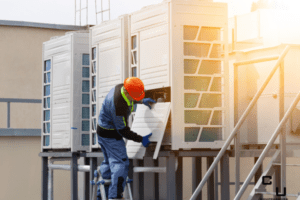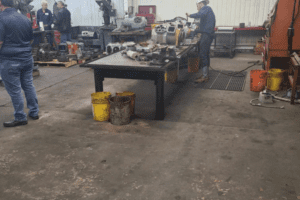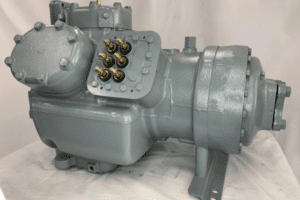Although the core principles of refrigeration remain the same, cooling a large building is a challenge.
The bigger your building is, the more opportunities there are for waste. For example, a large building may have hundreds of feet of ductwork, and clogs can develop anywhere within that sub-system. That, in turn, impairs airflow, reduces HVAC results, and makes the system work harder.
With that in mind, greater square footage increases the maintenance needs of the entire HVAC system. It is also more important that the system be planned and installed correctly. It must not only meet today’s needs, but be operated to maximize efficiency in the long term.
Let’s take a closer look at how to orchestrate HVAC for large buildings.
The Good News: The Basic Ideas Behind Refrigeration Remain the Same
As a facilities leader, you’re probably already familiar with the refrigeration cycle.
A compressor, possibly a Trane CHHB100, acts as the heart of your cooling system, compressing refrigerant to increase its pressure and temperature. This helps force the refrigerant through the system and into its next stop. The condenser blows hot outside air over the vapor to liquefy it, then its pressure is reduced by the expansion valve. Finally, heat is transferred by the evaporator, turning the cool liquid into a much warmer gas.
As long as you’re familiar with the compressor, condenser, evaporator, and thermal expansion valve, you will always be able to pinpoint problems in your system through process of elimination. Although a lot of attention is given to the compressor because of the amount of work it performs, most problems do not originate in the compressor – they result from maintenance failures or environmental issues elsewhere.
Weekly, monthly, quarterly, and annual maintenance checks and tests must be performed to keep the system running. In a large, complex HVAC system, different sections of the system can often be isolated so you don’t need to suspend HVAC service for the entire duration of your maintenance. If your system lacks redundancy, plan to perform checks on weekends, after hours, or during low traffic times.
The Three Different Kinds of Large HVAC Systems
When a building is new, the HVAC vendor should work with business management to understand how the property will be used, its occupancy levels, and factors such as heavy electrical equipment that can affect ambient temperature in different parts of the building.
Based on these and other factors, the HVAC system is planned and installed. Although there are many variations, there are three main approaches. These take into account the needs of the building’s end users, resources available for maintenance, and budget.
They are:
1. Single Split Systems
The most common system, it is found in smaller commercial buildings, although the square footage served still greatly exceeds the average home. The performance advantage of the single split system is the ability to control temperature levels in different areas of the building.
This is ideal if you have certain spaces, like server rooms, that require more intensive cooling.
These systems typically consolidate the air conditioning, refrigerant lines, and furnace systems into one central location that circulates air through a comprehensive network of ducts. To deliver on its granular control, however, each separate temperature zone you want to create requires its own outdoor unit.
2. Multi-Split Systems
Multi-split systems are becoming popular, particularly in new commercial and industrial construction.
Multi-split systems enable you to connect up to nine individual indoor units to a single outdoor unit. An advanced sensor network detects temperature changes and adjusts performance on the fly, contributing to greatly reduced energy use as long as the thermostat is properly calibrated.
Heat pumps in the multi-split system are also more effective. Their design works with the natural flow of warm air into cooler spaces, reducing the amount of mechanical work performed. The cost of installation tends to be higher, though this may be offset by efficiency savings over time.
3. Variable Refrigerant Flow (VRF) Systems
Also called Variable Refrigerant Volume (VRV), these are the most advanced HVAC systems found in large buildings. They are optimized for mixed-use structures like hotels: Businesses where temperature needs not only vary by time and location, but may also include areas with heavy heating or refrigeration needs.
The distinguishing factor in a VRF system is the efficient use of waste heat. Waste heat is unused thermal energy generated elsewhere in a business, such as the waste heat generated by cooled display cases at a grocery store. Warm air waste heat is captured and directed where it is needed throughout the building.
In practice, controlling costs in a large HVAC system means identifying likely points of failure, documenting and executing a maintenance plan, and preparing for the unexpected. In all three areas, facilities leaders are wise to explore the benefits and savings associated with remanufactured compressors.












